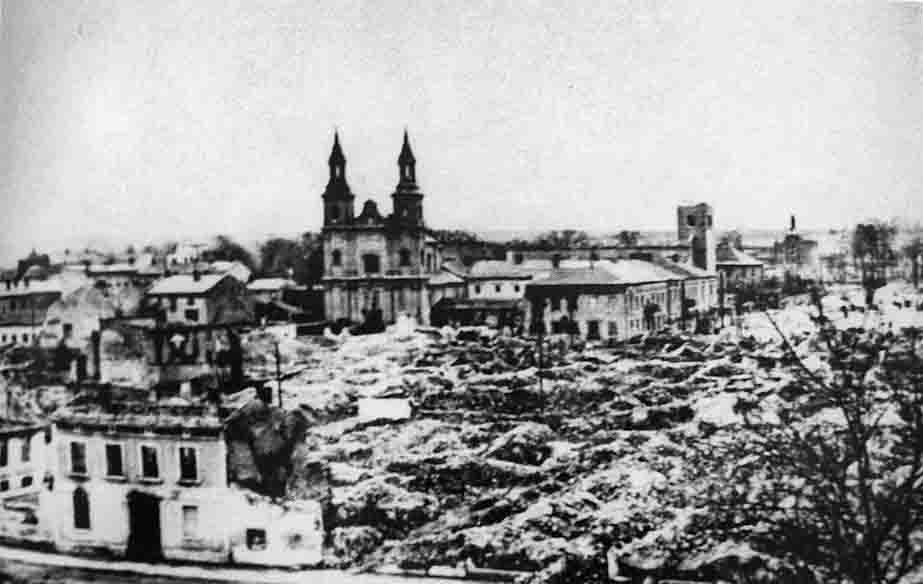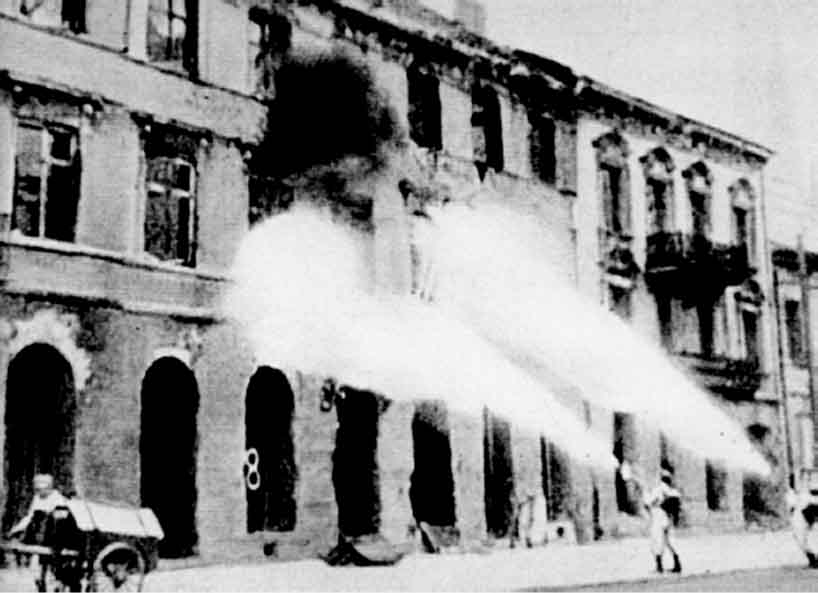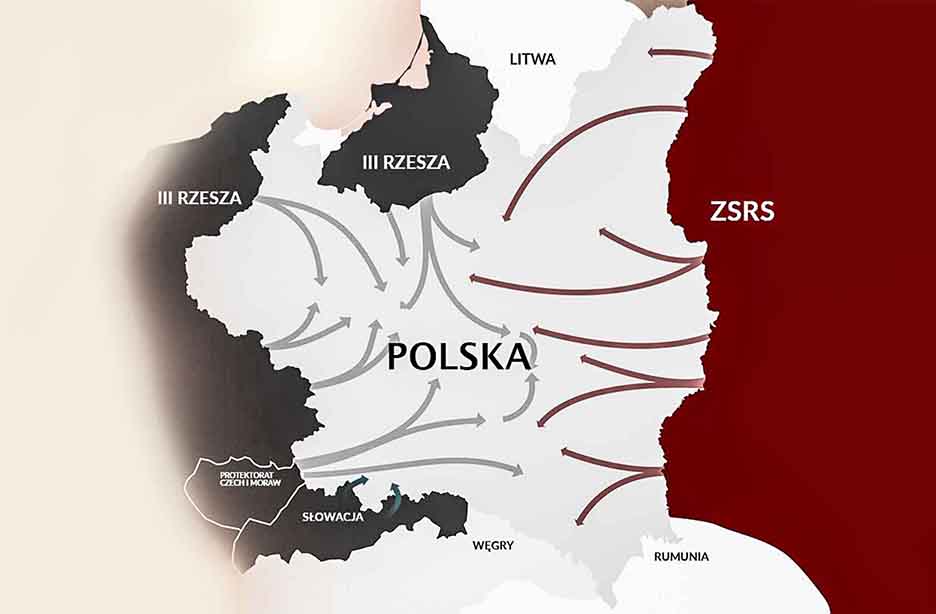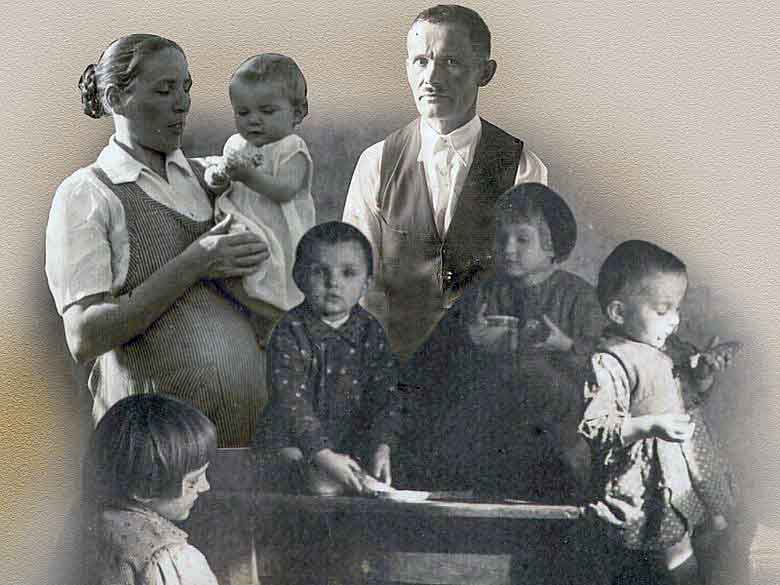After inflicting unprecedented death and destruction on Poland and its people during World War II, Germany arrogantly spurns Poland’s demand for reparations.
In October 2022, Polish Foreign Minister Zbigniew Rau signed a diplomatic note that was delivered to the German government requiring payment of war reparations. In late December, Germany delivered its insulting reply: “According to the German Government, the issue of reparations and compensation for war losses remains closed and the German Government does not intend to launch negotiations in this regard”.

Polish Minister of Foreign Affairs Zbigniew Rau at a press conference at the headquarters of the MFA Media Center in Warsaw. The head of the Ministry of Foreign Affairs signed a diplomatic note on reparations, which will be forwarded to German diplomacy. Warsaw, 03/10/2022. (Source: PAP/R. Pietruszka)
While the German government has never issued a formal statement explaining the logic for its refusal, three legalistic opinions are often presented in the media by those who believe Poland renounced its claim to reparations. These opinions are based on the Yalta and Potsdam Agreements, the so-called 1953 waiver, and the Two Plus Four Agreement. Each is invalid.
Poland was not a signatory to the Yalta and Potsdam Agreements, which were formalized in 1945 by the US, UK, and USSR. The Yalta Agreement required Germany to pay $22 billion in reparations, with half that amount to be paid to the Soviet Union, and of that half, 15 percent ($1.5 billion) was to be paid to Poland. This sum can by no means be considered fair compensation for Poland’s unprecedented human and material losses.

Wieluń, bombarded town center, 1939 (Source: Wikipedia)
A popular opinion in the German media has been the so-called 1953 waiver, which claims that, on 23 August 1953, the Council of Ministers allegedly renounced Poland’s claim to war reparations. The Chairman, Bolesław Bierut, read a Soviet-backed resolution, dated 19 August 1953, to the Council of Ministers that allegedly stated, “the Government of the Polish People’s Republic agrees with the Soviet government’s position on the waiver releasing the German Democratic Republic from liability for reparations as of 1 January 1954.” This is invalidated by the fact that the Polish Constitution at the time stated that ratification and termination of Poland’s international treaties, in this case an international treaty with East Germany, are within the authority of the Council of State, not the Council of Ministers.
The 1990 Two Plus Four Agreement was negotiated between the two Germanys and the four powers that occupied Germany at the end of the Second World War (the US, UK, USSR, and France) and it replaced the 1945 Potsdam Agreement. Because many regarded the Agreement as the effective closure of the War, it was presumed that any issue not addressed meant that the issue was to be considered closed. Although reparations were not addressed in the Agreement, it was commonly held that Poland de facto renounced its claims to reparations. This is, of course, nonsense. The Two Plus Four Agreement did not address Polish reparations nor was Poland a signatory to the Agreement.
Invalidating each of these so-called arguments is the Polish government’s recently published, three-volume report on Poland’s losses that is the result of several years of work by a team of experts from many different fields. The innovative methodologies used to develop the values of each category of losses have not been challenged and some have said that Berlin is stunned at the sophistication and thoroughness of the Report’s analyses. Kyiv likely is also taking note. The Report’s title is "The Report on the Losses Sustained by Poland as a Result of German Aggression and Occupation during the Second World War, 1939–1945" and its English version can be downloaded as a PDF here.
Demographic Losses
The Report begins with the loss of Polish lives under German occupation, which is estimated at 5,219,053 victims. About 2.4 million Poles were killed as were about 2.8 million Polish Jews. Poland suffered the highest relative population loss of the Second World War, which was the result of Hitler’s genocidal campaign to destroy Polish society.
A key component of Hitler’s campaign was the system of camps, which included concentration camps, death camps, resettlement and transitional camps, as well as forced and special labor camps. Concentration camps were even created for Polish children at Łódź and Potulice. Decapitation of Poland’s intelligentsia was another major component and at least 100 thousand persons are estimated to have been killed by Einsatzgruppen units and Volksdeutscher Selbstschutz paramilitary groups.
Another destructive measure was to restrict access to food and enforce starvation rations to weaken the population. Food rations were extremely small and those for Polish slave laborers were insufficient for survival. Polish Jews were in a worse situation as their rations were half those of Poles. Decreasing the overall birth rate was another harmful measure. Polish women who were slave laborers were forced to have abortions, and if they refused and gave birth to a child in Germany, it was taken away from them. The infant mortality for Polish babies in Germany was 50 percent and was artificially induced.
The abduction of approximately 196,000 “racially valuable” Polish children for Germanization was another destructive action. There was also Aktion T4, a special genocide operation in Germany that murdered handicapped and mental patients. Aktion T4 began in occupied Poland almost as soon as the Wehrmacht invaded. The use of gas to kill mental patients led to the construction of Sonderwagen, “special vehicles,” trucks with a specially converted freight compartment to make it airtight. Carbon monoxide was fed into it from a cylinder or the truck’s exhaust fumes were inserted. This became the first confirmed use of exhaust fumes to kill victims.

German Brennkommando burning Warsaw, 1944 (Source: Wikipedia)
In the Core Lands, 1.272 million Polish youngsters under 18 lost their lives, 708 thousand of whom were Jewish. Also overlooked are the aftereffects of Germany’s genocidal campaign, which greatly reduced Poland’s demographic potential and caused far-reaching outcomes felt to the present day. The shortfall between Poland’s demographic projection for 1950 and the actual figures for 1950 amounted to 12.83 million persons. As a result, the country’s base population fell drastically and more than 50 years were needed to make up for the losses.
Economic Valuation of Human Losses
The economic value of human losses was determined by calculating the earnings of Polish citizens who died between September 1939 and May 1945, were left disabled or seriously ill, were abducted as children for Germanization, and were slave laborers. The loss of GDP resulting from the lost wages of those who died in the War was based on the previously cited 5.2 million Polish citizen deaths.
Using the złoty-US dollar exchange rate as of 31 December 2021, this amounted to US $ 1.056 trillion. The loss of GDP from the lost wages of victims who survived the War was based on the number of invalids and the seriously ill, including the mentally ill, children abducted for Germanization, and slave laborers. The estimated loss of GDP for these categories is US $123 billion. Adding this amount to the US $1.056 trillion produces a total of US $1.179 trillion in lost wages.
Material Losses
Material losses encompassed the destruction of a wide range of properties including industrial infrastructure, electrical power generation, architecturally valuable historical buildings, agriculture, forestry, churches and places of worship, transportation system assets, and property losses of the Polish Army. All major industries, particularly steel mills, coal mines, the Chrzanów locomotive factory, the Cegielski heavy engineering plant, and chemical factories, were taken over by German companies, as were thousands of smaller businesses including craftsmen’s workshops.

Destroyed Warsaw Capital, January 1945 (Source: Wikipedia)
Archival documents confirm that, in the mid-1930s, Germany’s plan was to seize Polish property and exploit the Polish economy for its own needs, especially its war requirements. During the September 1939 invasion, the Germans avoided bombing Polish armaments factories because they planned to use them later in the War. One of the most advanced steelworks in Europe, Huta Stalowa Wola, was taken over and combined with the Reichswerke Hermann Göring concern to produce 88 mm anti-aircraft guns. The values calculated for each of the categories of material losses amount to a total of US $196 billion.
Poland’s Losses in Culture and the Arts
Germany’s plan was to wipe out Polish culture, which applied to all fields including literature, music, the theatre, cinematography, the fine arts, as well as Poland’s museums, architectural heritage, and monuments. Poland’s cultural losses are incomparable to German cultural damages in other countries. The German plan focused on looting cultural assets, destroying cultural products, exterminating those who created and contributed to culture, and dismantling Poland’s cultural organizational structure. Whole library collections of books were sent to the pulp mills and the contents of archives and rare collections were burned.
Many thousands of paintings were taken and shipped to Germany. It’s interesting to note that, according to current German law, after 30 years of possession, a looted work can’t be legally enforced for its return. The Germans also secured excavations and archaeological objects, which they believed would confirm the Germanness of the Polish lands.
All universities, colleges of higher education, and secondary schools were closed, and the only education available to Polish children were primary and vocational training schools. In many cultural fields, continuity from generation to generation was completely cut off as many of the seniors died without passing on their knowledge. The values calculated for the losses in Culture and the Arts amount to a total of US $5 billion.
Poland’s Losses in Banking and Insurance
All the assets of the three Polish state-owned banks (Bank Polski, Bank Gospodarstwa Krajowego and Państwowy Bank Rolny) were confiscated and put under the management of the Germans. All other Polish credit institutions were closed down, put under receivership, and their assets and liabilities were liquidated.
In the General Government, all local and foreign credit institutions were put under the authority of the Germans. All Polish credit and savings institutions were systematically robbed of its deposits. The value of Poland’s losses in banking and insurance is estimated at US $31 billion.
State Treasury Losses
The tax and monopoly assets of Poland’s State Treasury were taken by the Germans and used for their war economy.
The total estimated value of losses sustained by the Polish Ministry of the Treasury was US $121 billion, which does not include the material and human losses of the administrative operations of the Ministry of the Treasury.
Epilogue
Germany, together with its annexed Austrian partners in crime, murdered 5.2 million Polish citizens and caused US $1.572 trillion in Polish economic losses. Yet today, the legal successors of the Third Reich believe they have no obligation to compensate Poland or its people for the unprecedented death and destruction it inflicted.
Continuing to hide behind faux legalistic opinions proffered by biased media operatives, Germany’s leadership has also made the conscious decision to ignore its moral obligation. Despite the evident opportunity to negotiate a bilateral agreement on reparations and compensation, Germany avoids it like the plague.
Obviously, German political and economic interests take precedence over Poland’s indisputable right to compensation. What truly frustrates Poles is not being taken seriously. This is borne out in the Report by Jarosław Kaczyński, who emphatically states: “…it is absolutely inadmissible from the point of view of morality and dignity that Germany has paid out compensation of various kinds to 70 countries, but the Republic of Poland has been ignored.”
Berlin continues to close its eyes to the fact that Germany’s moral duty is to bear the responsibility that history imposes on it. Meanwhile, the need to reconcile its relationship with Poland continues to grow.














